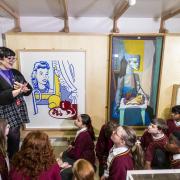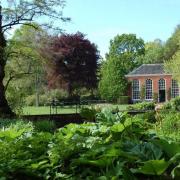Could there be buried treasure beneath your feet? Howard Bradbury joins Crewe and Nantwich Metal Detecting Society as they seek the answer to that question.

It’s not a bad morning’s work for Martin Tobitt. On the tip of his finger he holds an Elizabeth I silver penny which he has just dug up from about six inches below the surface of a field at Cotebrook, near Tarporley.
It’s quite likely the coin has lain in this spot for well over 400 years until Martin’s metal detector passed over it.
Could it have dropped from the pocket of a farm worker? Or perhaps it fell from the purse of a traveller stretching their legs at a rest stop on a long coach journey.
‘There was a stage coach point along here,’ surmises John Bereford, from Winsford, who is accompanying wife Joy on Crewe and Nantwich Metal Detecting Society’s fund-raising rally, scouring a large field in this picturesque setting.

Joy has brought along one of her own best metal detecting finds - a Bronze Age artefact which, ironically, is not made of metal.
‘It was in Weaverham. I threw my detector down in disgust and found a 5,000-year-old adze - a type of axe,’ says Joy. ‘It was just a chance find. it could have been fished out of the Weaver when they canalised it.’
Likewise, Martin - a retired bank manager and chair of the society, who lives near Nantwich - cites a non-metal object, a neolithic flint arrow head, as one of his favourite finds.
‘It’s not about value: it’s about the romantic side,’ he says.

In the early 1980s, Martin also unearthed a gold Saxon pendant which, under the old law on treasure trove, a coroner allowed him to keep. It ended up around his daughter’s neck as the ‘something old’ on her wedding day. Since then, the law has changed (see panel).
‘I recently found a stunning Saxon brooch made of silver,’ says Martin. ‘It’s certainly of regional importance, possibly national importance. That’s now with the British Museum and that’s very likely where it will stay.’
There are instances of detectorists striking it rich. The 2009 Staffordshire hoard - thousands of pieces of Anglo-Saxon gold and silver - yielded a £3m-plus reward for the finder and landowner.
But John Beresford says: ‘People don’t do it for the money; it’s not treasure hunting. people are interested in history.’

Another society member, Neil Bradley, from Nantwich, adds: ‘Every field has some kind of history. somebody has walked across it and dropped something.’
Sometimes, the detectorists are looking for very specific lost objects of more recent vintage. Don Corden, a society member from Kidsgrove, was called in when a lady playing a wild shot at Alsager Golf Club managed to propel her gold ring - a family heirloom - into the rough. Don detected it in little more than half an hour, trodden down out of sight by a well-meaning volunteer earlier in the search.
Don is currently trying to track down the relatives of the rightful owner of a football medal he found in Nantwich. The only clue is an inscription on the back reading: ‘Crossley C Cup, Runners Up, 1929-30’.
For Martin, the fascination with metal detecting was a natural development from an early interest in old coins. It was in 1975 that his brother-in-law showed him a metal detector.
‘I went into a field and found a Victorian penny almost straight away. I was hooked,’ he says.
These days, metal detectors are so sophisticated they even have GPS technology to record an exact location for finds.
I find Andy Jones, from Cuddington, scouring the fields at Cotebrook with his new metal detector costing £850, hoping the investment will yield another find to match the best of his 14 years of detecting - a Roman groat.
In the metal detecting community there is a suitably medieval name reserved for those who do not play by the rules: nighthawkers. These are treasure hunters who go on land without permission, often at night, and even invade protected archeological sites.
‘They cause major problems for archeological sites and they cause problems for the hobby,’ say Martin.
But, says Martin, the relationship between law-abiding detectorists and the archeological community has undergone a sea change over recent years.
‘The archeologists have come full circle,’ he says. ‘The vast majority of archeologists have now accepted us. The Portable Antiquities Scheme has helped.’



























